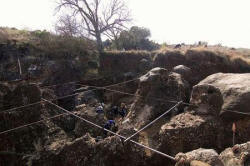|
 In
Africa's 'cradle,' an old fossil site yields new finds In
Africa's 'cradle,' an old fossil site yields new finds
 Send a link to a friend
Send a link to a friend
[July 28, 2015]
By Ed Stoddard
KROMDRAAI, South Africa (Reuters) -
Crouched in a shallow square grid dug into the red African earth,
American graduate student Sarah Edlund uses a hand brush to scrape soil
into a dustpan.
|
|
 She is uncovering scraping tools of a different kind -- implements
fashioned from quartz that were used 100,000 years ago to prepare
animal hides. She is uncovering scraping tools of a different kind -- implements
fashioned from quartz that were used 100,000 years ago to prepare
animal hides.
"We have found a lot of quartz and this is important because it is
not natural to this area ... It must have been brought here," Edlund
said as she topped up her bucket with soil before taking it to a
sifting device, where the dirt is separated from the quartz and
other potential scientific treasures.
The two-meter-by-two-meter grid was pegged out just a month ago, but
the site - Swartkrans - has been excavated for decades, yielding
hundreds of hominid fossils and shining a light on our evolutionary
past stretching back almost 2 million years.
The new ground being broken on a rocky hillside 25 km (15 miles)
northwest of Johannesburg helps to reveal the material culture of
our ancestors a thousand millennia ago, shortly after they had
evolved into our species, Homo sapiens.

"In this area we have what are mostly called scrapers, a certain
form of stone tool," said Travis Pickering, a professor of
anthropology at the University of Wisconsin.
The reason behind this conjecture is simple: modern humans also
scrape and prepare hides with similar tools. Clothing and perhaps
shelter would have been the most likely end product of the hides.
Much of the quartz retrieved at the site is in the form of flakes
that may have come off while a tool was being fashioned.
The scrapers themselves are fairly basic: a piece of quartz worked
so that the edge can be used to literally scrape a hide from an
animal.
But what is striking is the sheer number unearthed, and what that
suggests about our social development 100,000 years ago.
"There is a preponderance of them here, and what we think is this is
perhaps a specialization site, where they were working hides. And
that is indicative of a very cognitively advanced sort of society,"
said Pickering, who directs the research project at Swartkrans.
[to top of second column] |

It also underscores the layered anthropological richness of the
area, which includes the famed Sterkfontein caves across the valley,
when it comes to the story of human evolution.
Over 30 years ago, paleoanthropologist Bob Brain uncovered
humanity's first use of fire here over a million years ago.
Party to the discovery was the famed British travel writer Bruce
Chatwin, who was fascinated by Brain's theory that humanity's
evolutionary path was blazed by our attempts to avoid being eaten by
predators.
Recalling his discovery of burned bones at the site, Brain, now a
spritely 84, told Reuters that the use of fire "was an attempt to
evade the constant danger at night of the predators just waiting for
their meals.
"This story has slowly come out of this excavation, which I was
involved with for 50 years," he said.
(Editing by Michael Roddy and Mark Heinrich)
[© 2015 Thomson Reuters. All rights
reserved.]
Copyright 2015 Reuters. All rights reserved. This material may not be published,
broadcast, rewritten or redistributed.

 |